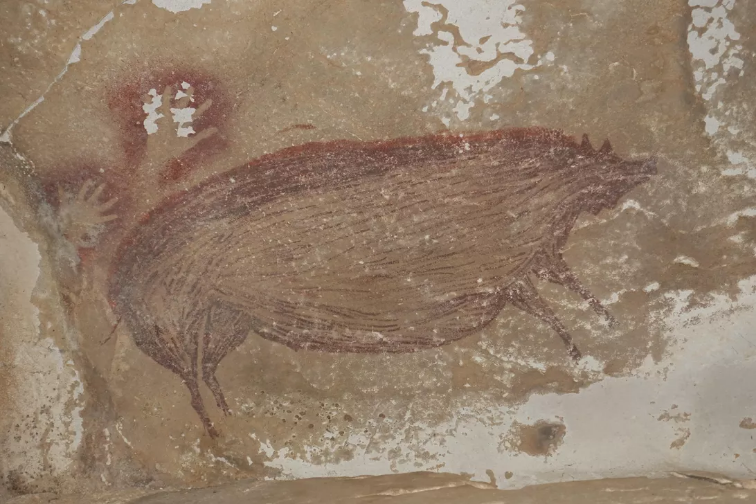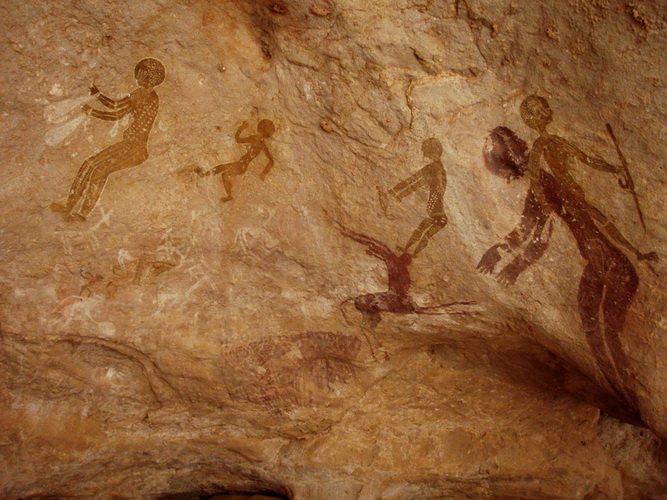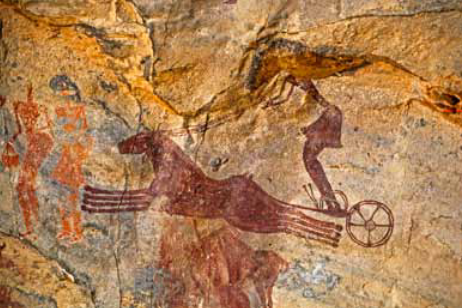You may have read in the news recently how, in 2018, researchers trekked on foot deep into the Colombian Amazon looking for our ancient history. They snuck around venomous snakes, crept past FARC guerillas, and avoided caimans, finally reaching difficult and remote cliff walls. There they discovered tens of thousands of drawings on the rock walls dating back over twelve thousand years. The discovery is amazing for human history and anthropology. It shows what people thought about and cared about. There are designs as well as human and animal figures. There are even hand prints of these ancient humans. But as amazing as all that is, it is only half of the story.
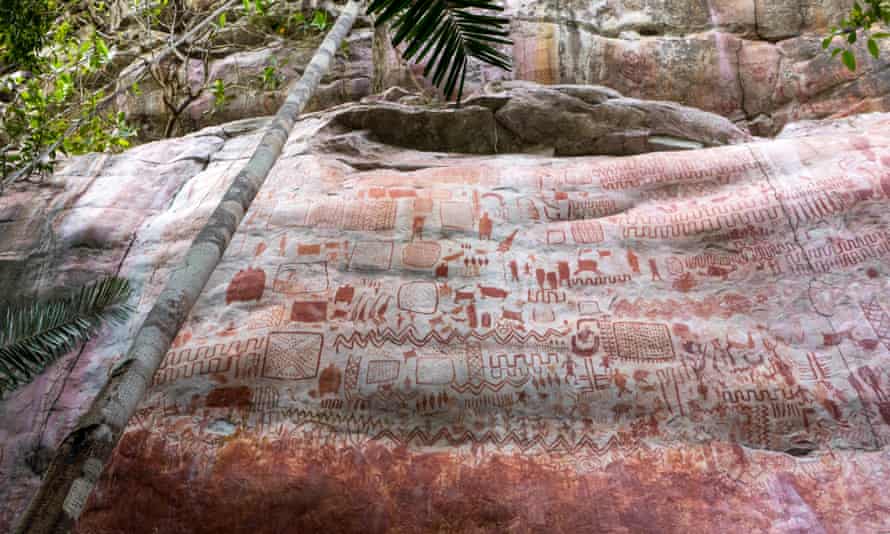
These paintings, made in red ocher, don’t just depict animals, they depict animals long extinct. They depict an amazon long gone. The world had only just exited the previous ice age, and the world’s ecosystems were rapidly changing–amazon included. This art is a window into the world as it was. Sure we have fossils, pollen from cores, diatoms, and other natural remains to examine, but learning about our natural history through our own art is much more personal. After all, what is humanity without the world around us? Perhaps the art was religious, perhaps it was for fun, or perhaps it was for teaching. Whatever the reasons, it is an astounding find with implications for learning about both human and natural history.
One of the reasons we know a minimum age for the paintings is that they contain images of mastodons, which have not been in South America for 12,500 years. Ignoring the astonishment that such a number of years can be, take a moment to think of what a mastodon is–making sure you are not thinking of a woolly mammoth–and then picture that in the Amazon. It is difficult, and it should be. That long ago, the area was not a rain forest, but more like a savanna. Other extinct creatures painted on these rock walls include palaeolamas, giant sloths, and ice-age horses, likely with more paintings yet to be identified, such as giant armadillos. José Iriarte, the project leader stated, “The pictures are so natural and so well-made that we have few doubts that you’re looking at a horse, for example. The ice-age horse had a wild, heavy face. It’s so detailed, we can even see the horse hair. It’s fascinating.”

Humans have been around a VERY long time. So long that we really cannot grasp the length. We are like children who think a 10 year old is “soooo old,” but multiplied a thousand times over. What’s more, Homo neanderthalensis beat Homo sapiens to art by tens of thousands of years. There is neanderthal eagle talon jewelry dated to 130,000 years ago, decorative shells dated to 117,000, and cave wall art to over 66,000 (three Spanish caves have Neanderthal drawings dating to this era: 64,800 in Cave of La Pasiego, 65,500 at Cave of Ardales, and 66,700 in Cave of Maltravieso). Thus, when we talk about art, we should not only include modern human art, but neanderthal art as well. They beat us to it and should be recognized for it. Thus, around the world, and possibly across different species in our genus, we have artwork of ancient ecosystems and extinct animals.
Aside from neanderthals, there are three other species in the genus Homo who lived recently enough to have created cave art. Recently researchers have recently discovered paintings in caves in Borneo and Sulawesi dating back to at least 40,000 years. Twice, this has caused anthropologists to reconsider the dates of the earliest figurative drawings (rather than a stencil of a hand or lines on the wall, but an actual drawing of an animal) known. The added significant to this is that these works actually predate the earliest known Homo sapiens in the area. This doesn’t mean that there definitely were not humans, but it is possible it was another group, such as Homo denisova whose DNA now makes up 7%-8% of Papuans and existed at least as recently as 30,000 years ago. Or they could have been the “hobbit” humans (Homo floresiensis) who lived in Indonesia as recently as 50,000 years. Then there are the Red Deer Cave People (unknown taxonomy) who lived in China as recently as 11,500 years ago, or Homo luzonensis as recently as 50,000 years ago, though only known from the Philippines. And there very well could have been a possible as-of-yet unknown Homo species.
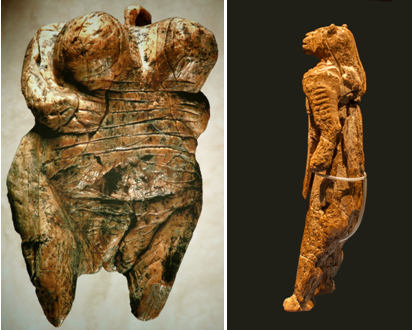
Cave and rock wall art and ancient figurative art are certainly not limited to tropical areas, and in fact, the oldest known representative art of a human is the Venus of Hohle Fels in Germany along with a human-lion figurine from nearby. And while not visual art, a 42,000 year old bone flute was found near the Venus.
Now, you might say, “Wait a second, those are not about changing ecology!” But the lion head is. Lions in Germany? Yes, they lived there alongside humans. In fact, European cave lions were painted in the Lascaux cave in France and are over 20,000 years younger than this figurine. The Lascaux cave paintings are perhaps the most famous of all cave art, with about 1,400 paintings dating back 15,000-17,000 years. They may seem young relative to art 40,000 years old, but that is still over 800 generations ago. The relative youth of the caves are perhaps why the artwork is much more detailed, with the rendering of the animals more precise. Extinct animals painted there include a giant deer, the megaloceros, cave lions, aurochs, woolly rhinoceros, steppe bison, as well as animals extinct in the area such as reindeer, European bison, and horses.
This phenomenon really is world-wide. In Australia, there are thousands of rock paintings that have survived for tens of thousands of years, with some controversy that they may even be as old as the oldest cave paintings in Indonesia. There is a painting of a marsupial lion, an animal extinct for 30,000 years. In Western Australia, there are thousands of carvings in the Murujuga dating back 30,000 years including the earliest image of a human face (the Venus of Hohle Fels has no face that we know of) and Tasmanian tigers. People also claim there is fat-tailed kangaroo, but I have found no evidence that it was a real species and is likely just a bad carving. There is also a painting that may be of a Genyornis newtoni, a flightless bird over 2 meters in height that became extinct not long (relatively) after humans arrived (50,000 years ago) on the continent. However, the painting is not convincingly a Genyornis and could be an emu or some other crudely-drawn bird. Still, it is fascinating.

As a side note, the Blombos cave currently holds the record for earliest drawing by a Homo sapien at 73,000 years ago, though we do not know if the lines of ocher on a stone fragment were supposed to be art or something more mundane. Personally, I find the carved pieces of ocher and shell beads to be much more interesting, which date from 70,000 to 100,000 years ago. Unfortunately, until I find out something about the shells themselves, none of this is really natural history art.
Caves and rock walls across the world repeat this theme of a changing landscape. Sometimes the landscape changes are due to long-term climate shifts, other times due to human interference, but often it is a result of both. In the Rock Shelters of Bhimbetka, a 10,000 year old site in India, there are images of elephants (no longer living in the area), swamp deer (mostly extirpated), rhinoceros (no longer in the area), bison, and tigers. The 15,000-20,000 year old Khoit Tsenkher cave in Mongolia has ancient depictions of buffalo, mammoths, oxen, ibex, lions, argali, antelopes, camels, elephants, and ostriches, most of which clearly no longer live there. The Kapova Cave in the Urals of southwestern Russia has ancient depictions of several species including woolly rhinoceros, mammoths that date back 17,000-19,000 years. Most surprisingly, however, is the 14,000-37,000 year old drawing of a double-humped camel, though there is no evidence any lived in the region at that time, suggesting the artist him/herself actually traveled a long distance. A nearby cave, Ignatievskaya Cave, likewise has a camel. All around the world there is ancient art of ancient peoples and animals, and like the Amazonian rock walls, more and more is being discovered every year.
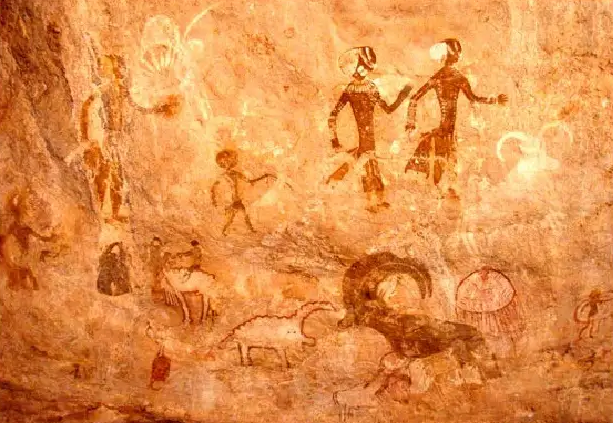
One of the best case-studies of the evolution of ecosystems being reflected in ancient art is younger than many discussed previously, but at the still ancient age of 10,000-12,000 years, with artwork continuing until the late classical period. The Tassili cave and rock wall system (it’s a pretty large rocky complex) of southeastern Algeria and its more than 15,000 drawings is perhaps the most emblematic of the point in this article. The cave art depicts a lot of changes that happened in those relatively rapid millennia in both the human and natural world. The artwork is typically divided into semi-distinct eras, but there is little agreement about when those eras existed (and often slight variations in the names given), even among people who use the same era classification, and to be fair, dating rock art is rarely very exact and a complex of methodologies is required. Thus, I will be very generous with the dates I use. starting with drawings that predate agriculture. The periods are the Wild Animal Period, the Round Head Period, the Cattle Period, the Horse Period, and the Camel Period.
In the Wild Animal Period, starting 10,000-12,000 years ago and ending 4,000-6,000 years ago (you will see there is much overlap in the periods for good reason), the Sahara was a wildly different environment. At this time, the region around Tassili was not sandy desert, but full of wildlife and more like a savanna. There are drawings of extinct buffalo and aurochs as well as elephants, rhinoceros, hippopotami, antelopes, giraffes, and crocodiles, who, while not extinct, are no longer living in this arid landscape. Fortunately, mouflons, at least, still survive nearby to this day.
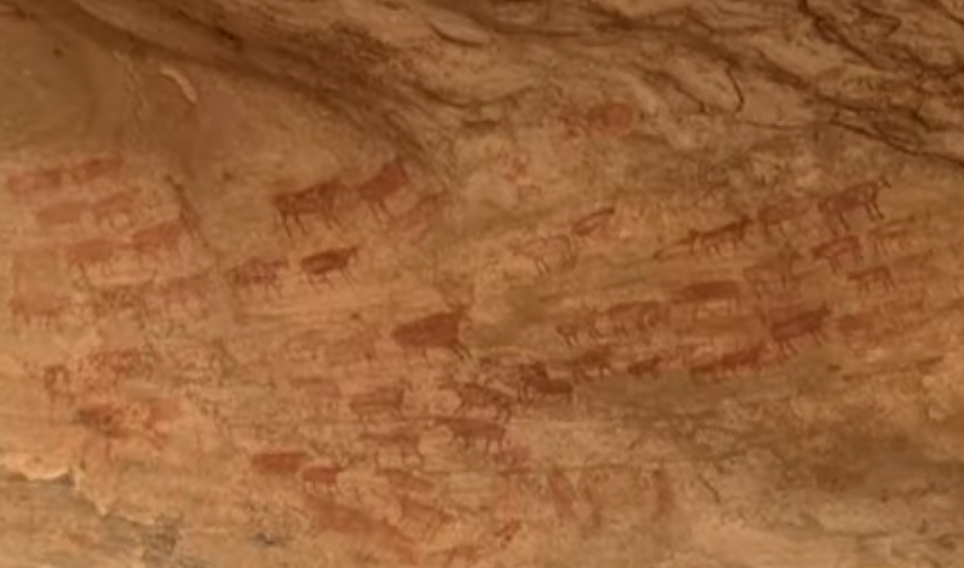
After this early period, North Africa saw a major shift with the introduction of domesticated cattle about 6,500-7,200 years ago, and many of the paintings of this era show that distinct shift. This period lasts until the advent of horses to the region 2,000-4,000 years later. And nestled in there, is this strange period, the Round Head Period, named so because of the depictions of humans with round heads and featureless bodies. It is typically believed that while contemporaneous, the artists of the Round Head Period and those of the Large Animal Period were different. This period lasted from around 8,500-10,000 years ago and ended around 7,000 years ago. The fact that we see different artistic styles from people who lived at the same time is very interesting, possibly demonstrating different competing schools by people who clearly knew each other. Though some posit that there might have been competing tribes, and as we know, tribalism can push even art into separate and distinct styles.
As previously mentioned, the next era is after the introduction of horses. This period shows a change in attitudes as the pastoral life disappears and more interest in horses, men, and war appear.And then finally, it arrives at the introduction of camels at around the start of the common era. Finally we arrive at the Camel Period which, contrary to biblical understanding, does not occur until around Jesus’s birth (at least we have many deposits of animal bones from the biblical era, but none of camels until around the start of the common era). Around Tassili, the Sahara truly changed, and while its location marks it as a relatively wet location, it is not the savanna that the early artists loved.
So while this focused on rock wall art, with a couple minor exceptions, it is important to keep in mind that those exceptions become more and more significant as time goes on. As we saw in a previous post, the relatively recent artwork of John James Audubon depicts now-extinct American birds. We had little understanding of what was happening in his day, but now we know that many species that exist today will not exist in 2022. Art is not just our culture, but our record for tens of thousands of years.
There are four lessons learned during this research that were outside the original scope. The first is that science reporting is so often awful. I found so many articles claiming that one carving indicated an extinct species despite no other evidence that it ever existed. I found an article title that claimed some art was 40,000 years old, but the text claimed it was 14,000-37,000 years old. Ridiculous. There were articles claiming that drawings that could be one thing or another similar one were surely the thing that made it many thousands of years older, without any supporting evidence. The list goes on. Second, the science is evolving in dating rock wall art and new discoveries of ancient art are constantly being made. Even a few months can change our understanding of significant human events. Next, people need to stop declaring all non-figurative art as “abstract.” We should stop giving intention where we do not know it exists. Last of all, vandalism is just awful. Here we have art going back to our ancient ancestors and so many people can’t think of anything better than to permanently destroy it with some crude spray paint or scratches. Bonus lesson: UNESCO doesn’t seem to know what its sites are about, suggesting it’s just an application to receive a fancy title and play politics.

